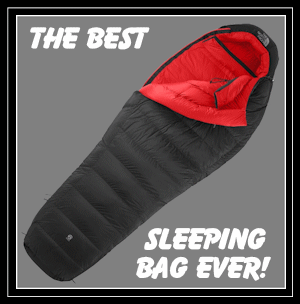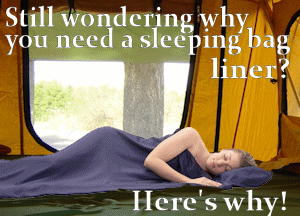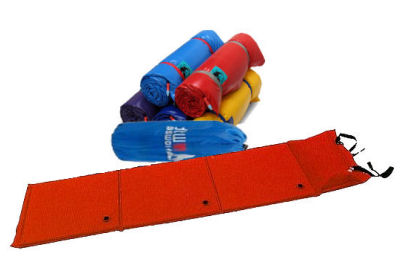Self-Inflating Sleeping Pads – How they work and How to Pick One

What are the best self-inflating sleeping pads, and how do they work? Do I really need a sleeping pad designed for camping? Does it really matter what they are made of? If those are your questions – the answers are simple.
What is a self-inflating sleeping pad?
Simply an open-cell foam pad enclosed in a plastic case with an air valve. Like a sponge in a plastic bag. They are sized to accommodate cots and sleeping bags, with an outer fabric covering to protect the plastic case.
Squeeze the sponge to get the air out, seal the bag, and it’s compressed. Open the bag and the sponge sucks in air and expands. That’s the concept of self-inflating sleeping pads.
How does a self-inflating sleeping pad work?
- When the pad is compressed and the air valve is closed, air can’t get in and the foam cells remain collapsed and compact for transport and storage.
The natural state of these cells is to be expanded, so when you open the air valve, (unseal the bag), the cells can suck in air to allow them to expand to their natural state – inflated.
- When you then close the air valve, (re-seal the bag), the air is trapped in the foam cells. That turns them into an air and foam cushion.
Yes, you do need a sleeping pad designed for camping
- A camping environment is not like the dry floors or carpets at home, there are a lot of things in the camp that can rip, puncture, and damage a cheap sleeping pad.
*Amazon’s prices on quality camping gear are so good that I have no problem using my affiliate links to recommend them
How do I decide on the best sleeping pad for me?
- Sleeping pads serve two primary purposes: As an insulation layer between you and the cold ground, and as a cushion between you and the hard bumpy ground.
- A pad’s insulating factors are determined by its thickness, and what it’s made of. Open-cell pads are generally thicker and have larger dead-air spaces in their cells than closed-cell pads, so they are better insulators. Whether the insulation factor should be your primary concern depends on the temperatures you camp in.
- A pad’s thickness, (and quality of materials), determines its comfort cushioning ability. If pack weight is not a factor, (few backpackers use self-inflating pads, because of their weight), then thicker is better. Most pads range from 1 to 2 inches thick when inflated – let your wallet be your guide.
*there are light-weight sleeping pad models
- The outer fabric of the pad is also very important. It protects the plastic inner cover that allows the pad to work. So consider your typical camping conditions; if you always use a cot, then the covering material doesn’t need to be as sturdy as it would if you usually sleep on rocky or rough ground. (even inside a tent)
- Size – obviously sleeping pads come in different sizes. From kids to women to x-large man-size. A too-small sleeping pad will make for a miserable night’s sleep – make sure your choice is sized for the camper(s) using it.
- Compare the self-inflating pad’s specs to your needs:
- Length: At the least, your shoulders and hips should fit on the pad. Regular (typically 72″ long) and long (from 75″ to 78″) pads will also insulate your legs and feet, and make for a better night’s sleep. A short or 3/4-length pad (usually 47″ or 48″) weighs less and packs smaller, but it is an obvious comfort trade-off.
- Width: Almost all pads come in a standard width of 20″. If you roll around a lot, you may want a wider width of 25″ or 30″ found in some large sizes. Tapered designs reduce the volume a bit and pack smaller, but may be felt as a trade-off if those aren’t your priorities.
- Insulating R-value: Insulation is measured according to its capacity to resist heat flow, and ranges from 1.0 (minimally insulated) to 9.5 (well insulated). Thicker pads generally offer higher R-values.
- Your budget and the bells and whistles.
- Everyone wants the latest and greatest – regardless of whether the extras are really needed, so think about what features you need first, and look for the sleeping pad that has the best quality of those features. Consider your need for; cot straps, built-in pillows, non-slip bottom layer, multiple air chambers, roll-up straps/bands, and stuff-sacks.
Desirable sleeping pad features:
- Stuff-sack or carry-straps, you soon discover these are not luxuries
- Wrap bands or straps to keep the bag rolled up. Even if it goes into a bag.
- Patch repair kit – most quality brands include these – if not, give your brand choice some more thought.

Not only do you get the security of dealing with the largest and most trusted online marketplace, and discount prices – now you also get FREE shipping. Keep that “shipping” money in your wallet.

Recommended Self-Inflating Sleeping Pads for Camping
Price range: $24.95 – $229.99
• THERM-A-REST Self-inflating Sleeping Pads
★★★★★ Top Pick for Tent Camping
Therm-a-rest was the originator of self-inflating sleeping pads, and is still one of the top brands for quality and performance, but they made the top-pick because this is the sleeping pad I have used for the last 5 camping seasons, (on the ground tent camping), and it still inflates as quickly as it did when new. Plus the fact that these old bones appreciate the 2″ cushion.
Rating: Best Buy in the $49.99 to $109.99 price range
Note: This item, as well as almost all camping items on Amazon qualifies for Free shipping on orders over $35
• Kelty Self-inflating Sleeping Pads
★★★★★ Top Pick for Camping
Kelty, another leading brand in camping equipment, is recognized by campers everywhere as a manufacturer of top quality camping gear, and their self-inflating sleeping pads are no exception.
Available with thick 2.5 inch foam support, suede top fabric for comfort, and attached lash-straps compress the pad to a mere 33 oz.
Rating: Best Buy in the $66 to $85.85 price range
• Alps Self-inflating Sleeping Pads
★★★★★ Top Pick for Camping
Strong brands in camping gear are strong for a reason. These Alps series sleeping pads are an example why.
- JetStream foam for super fast inflation and deflation
- Anti-slip “PVC Dot” bottom Fabric
- Polyurethane open-cell foam
- Non-corrosive brass valves
- Stuff sack and repair kit are included
Here are a few other camping equipment items and resources that may prove helpful:
|
|
Companion guides:

Sleeping Bag Guide
★ Why you should use a sleeping bag liner

Sleeping Bag Guide

• Camping Tent Lights
For their convenience, and peace of mind, a portable tent light will make tent camping life easier for everyone. These new LED tent lights make batteries seem to last forever. And many of them also have a night-light setting for younger campers that are used to having them at home.

• Folding Camp Cots
Sleep in comfort with your new sleeping pad on one of these lightweight folding camp cots. From basic to Cadillac, pup tents to family tents, amazon has a camp cot for your needs.

Winter and cold weather camping gear and clothes.
From hats to boots, base layer to outer layer, plus recommended top-picks.
See what to wear, and why cotton is your cold weather enemy.
How to Dress for Winter Camping
Tip: With young kids in camp, a portable camp toilet will make your life a lot easier. No interruptions for a long trip to the campsite bathrooms, and no “scary” after dark trips to the latrine in the woods.
ps. You will be surprised how convenient and inexpensive portable camp toilets are. Here are some cheap portable camp toilets on Amazon. Check them out.
|
Was this helpful? Help us share Campingwithgus.com by giving us a “Like” |
 |
Related sleeping bag resources:
★ How to pick the best sleeping bags for kids
★ See why you should use a sleeping bag liner
Related Resources:
|
|
You might also like:
Return to CampingwithGus.com Home page













